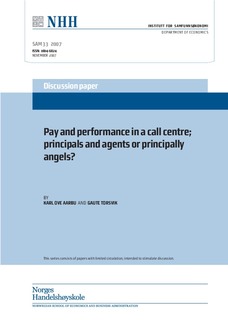| dc.contributor.author | Aarbu, Karl Ove | |
| dc.contributor.author | Torsvik, Gaute | |
| dc.date.accessioned | 2008-08-27T13:12:02Z | |
| dc.date.available | 2008-08-27T13:12:02Z | |
| dc.date.issued | 2007-11 | |
| dc.identifier.issn | 0804-6824 | |
| dc.identifier.uri | http://hdl.handle.net/11250/163118 | |
| dc.description.abstract | We use data from a pay reform in an insurance company to contrast
different theories of work motivations. The management installed
performance pay to boost sales in the customer service centre of the
company. The reform was successful. The bonus scheme gave the operators
both self-regarding and other-regarding incentives to increase
sales. The increase in sales does therefore not in itself help us identify
the underlying motivation of the workers. However, when we examine
the evolution of the design and impact of the scheme, we conclude
that the standard principal-agent model best explains the patterns in
our data. | en |
| dc.language.iso | eng | en |
| dc.publisher | Norwegian School of Economics and Business Administration. Department of Economics | en |
| dc.relation.ispartofseries | Discussion paper | en |
| dc.relation.ispartofseries | 2007:33 | en |
| dc.subject | team incentives | en |
| dc.subject | multi-task | en |
| dc.subject | reciprocity | en |
| dc.subject | fairness | en |
| dc.title | Pay and performance in a call centre : principals and agents or principally angels? | en |
| dc.type | Working paper | en |
| dc.subject.nsi | VDP::Samfunnsvitenskap: 200::Økonomi: 210::Samfunnsøkonomi: 212 | en |
